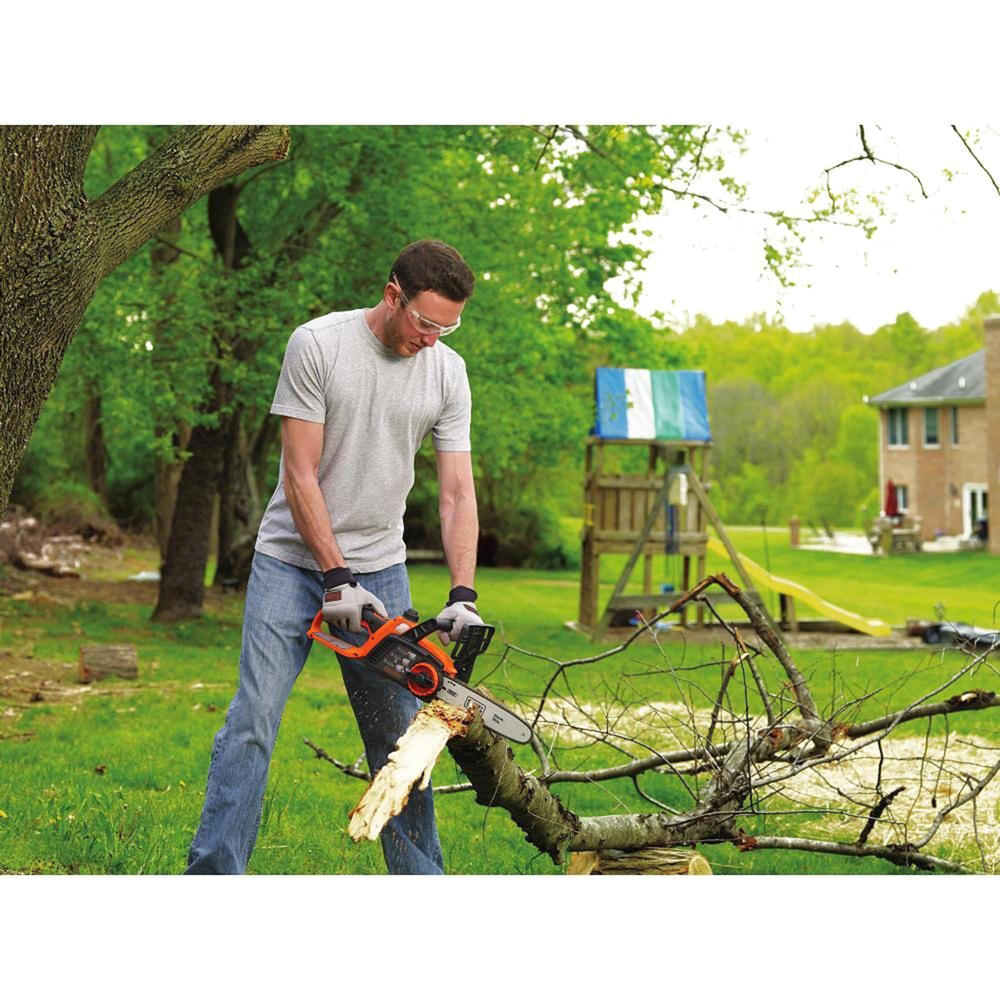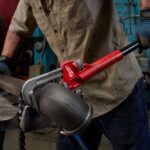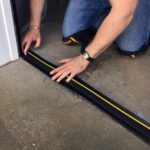Mini Chain Saw
A mini chain saw, also known as a pocket chain saw, is a small, portable version of a regular chainsaw. As the name suggests, it has a short bar and chain that allows the saw to be used for light-duty cutting and trimming tasks where maneuverability and ease of use are key.
Mini chain saws offer a few advantages over full-sized models:
- Portability – They are lightweight (typically 2-5 lbs) and compact, making them easy to carry and use in tight spaces. Many have a built-in handle for easy carrying.
- Safety – The short bar length and lower chain speed make them safer for incidental trimming jobs. Less kickback risk.
- Low maintenance – Smaller engines mean less maintenance and easier storage.
- Affordability – Good for DIYers who only need a saw occasionally. More budget-friendly than professional models.
Mini chain saws work best for small jobs like pruning tree limbs, cutting small logs, clearing brush, and trimming hedges. They can make quick work of tasks that would otherwise require hand saws or loppers.
However, the trade-off is less power and cutting capacity compared to full-size chainsaws. Mini models aren’t intended for heavy duty use like felling trees or milling lumber. The bar length is usually 10 inches or less.
Overall, mini chain saws fill a niche for portable, casual use where their size and safety features are advantageous. They offer an affordable and easy way for homeowners to trim and prune around their property.
Table of Contents
Safety
Operating a mini chain saws requires taking proper safety precautions to avoid injury. Protective equipment like gloves, goggles, ear protection, and steel-toe boots should always be worn. Before starting the saw, inspect the area and remove any debris or obstacles.
Always use two hands to operate the saw and maintain a solid stance. Keep the saw close to your body and watch for kickback, which can happen if the rotating chain touches something unexpectedly. Make sure the material you’re cutting is well supported. Take your time and don’t overextend yourself.
Some common mini chain saws injuries include lacerations from the moving chain, injuries from kickback, getting body parts pinched in the mechanism, and hearing loss from the loud noise. Wearing appropriate safety gear greatly reduces the risks. Maintain focus and don’t let your attention waver while operating the saw. Proper training is essential before using this potentially dangerous tool.
Features
Mini chain saws are smaller and lighter than regular full-sized chain saws, making them easier to handle and maneuver. Here are some key features to look for when choosing a mini chain saw:
Size and Weight
- Mini chain saws typically weigh between 5-15 pounds. This makes them easy to carry and use without tiring.
- They have compact sizes with bar lengths around 10-14 inches. The small size allows using them in tight spaces.
Guide Bar Length
- Guide bar length on mini saws ranges from 6 inches to 14 inches.
- Shorter bars from 6-10 inches are good for light pruning and trimming.
- Longer 10-14 inch bars can handle thicker branches and logs.
Engine Power
- Mini chain saw engines are lower powered, usually between 30cc-50cc. This reduces weight.
- Most operate at 3600-4000 RPM no load speed. Enough for cutting jobs but lower noise.
- Electric mini saws have lower power, typically 30V to 80V. Battery life is important.
Chain Type
- Most mini saws use 0.25 inch pitch chain with smaller drive links than standard saws.
- Chain gauge is around 0.043 inches for good cutting ability balanced with low kickback.
- Chains are narrower as well to match the shorter bar, often 3/8 inches wide.
So in summary, mini chain saws offer lighter weight, electric options, shorter bars, lower noise and kickback – ideal for light, occasional cutting tasks and tighter spaces.
Uses
Mini chain saws have become popular for a variety of uses beyond their original purpose of pruning and trimming branches. Their compact size and maneuverability make them ideal for tasks that require more precision and control. Here are some of the most common uses for mini chain saws:
Pruning
Mini chain saws are excellent for pruning trees, bushes, shrubs, and other plants. Their small bar length allows you to make precise cuts in tight spaces. Pruning helps promote plant health by removing dead or damaged branches. It also helps shape plants and trees aesthetically. A mini chain saw gives you more control for detailed pruning work.
Limbing
Limbing involves removing branches from a fallen tree or log. It’s an important step in processing firewood. Mini chain saws are lightweight and easy to handle overhead when limbing a tree. Their compact size also reduces fatigue for prolonged limbing tasks. The small bar length lets you cleanly cut limbs in tight crotches.
Cutting Firewood
A mini chain saw can cut small logs, branches, and lumber to length for firewood. The smaller bar length makes it easier to handle short logs compared to a full-size chain saw. Mini chain saws are great for cutting kindling as well. Their portability also makes it convenient to bring along on camping trips for gathering firewood.
Arts and Crafts
The precision of mini chain saws makes them useful for detailed arts and crafts projects as well. You can use them to carve sculptures from wood or cut unique shapes and designs. Some mini chain saws even come with specialized carving bars and chains. The ability to intricately shape and sculpt wood expands the creative possibilities with a mini chain saw.
So whether you need to prune trees, cut firewood, or create art, a mini chain saw provides versatility beyond typical yard work. Their portable size and specialized features open up a wide range of uses.
Maintenance
Proper maintenance is crucial for keeping your mini chain saw running safely and efficiently. Here are some key maintenance tasks to remember:
Chain Sharpening and Replacement
- The chain on a mini chain saw needs to be kept sharp to maximize cutting performance. Use a round file and file guide to periodically sharpen the cutters along the top and side edges.
- Replace the chain when it becomes too worn. Look for stretched or bent cutters, uneven cutting, or excessive sawdust production as signs it’s time for a new chain.
- Make sure to replace the chain with one specifically designed for your saw model. Refer to the owner’s manual for proper size and pitch.
Air Filter Cleaning
- A dirty air filter can restrict proper airflow to the engine. Locate the air filter cover and unsnap it to access the filter.
- Remove the filter and tap it on a hard surface or use compressed air to remove dirt and debris. Avoid washing the filter if possible.
- If the filter is excessively dirty, replace it with a new one. Check the filter at least every 5 hours of use.
Fuel and Oil Mix
- Mini chain saws require a gasoline and 2-stroke engine oil mix for fuel. Consult your owner’s manual for the proper fuel ratio, usually around 50:1.
- Use fresh, high-quality unleaded gasoline and 2-stroke oil designed for air-cooled engines.
- Always mix the fuel in a separate container before adding it to the saw’s fuel tank. Shake the mixture thoroughly before each use.
- Check the fuel level before each use and top off when low. Never run the saw dry or with old, contaminated fuel.
Proper maintenance keeps the mini chain saw running safely and optimizes cutting performance. Follow the manufacturer’s recommendations for any additional maintenance procedures.
Top Brands
Mini chain saws come in a variety of brands, with some key players being Stihl, Husqvarna, Echo, and Makita. Here’s an overview of some of the top mini chain saw brands on the market:
Stihl
Stihl is one of the most well-known and reputable chain saw brands. They are known for making professional-grade equipment that is powerful and durable. Some of Stihl’s key mini chain saw models include the MS 150 C-E and MS 151 C-E.
Stihl mini chain saws feature anti-vibration technology, tool-free chain tensioning, and easy starts. They are lightweight but pack plenty of power. Stihl saws are more expensive but known for their reliability and quality construction.
Husqvarna
Husqvarna is another leading brand when it comes to chain saws and outdoor power equipment. Their 120i and 120 Mark II are two of their most popular compact chain saw models.
Husqvarna mini saws emphasize ergonomic design, low vibration, and ease of use. They are designed to be comfortable and easy to operate. Husqvarna chain saws are also priced at a premium level but deliver robust performance.
Echo
Echo produces a wide range of chain saws at various price points. Their CS-271T and CS-303T are two examples of Echo mini chain saws perfect for light tasks.
Echo mini saws focus on value, delivering professional-grade features at a more budget-friendly price point. They are easy to start and maneuver while still providing Echo’s signature reliability.
Makita
Makita makes several compact chain saw models like the UC3551A and UC4051A. Makita mini saws highlight efficient, low-emission engines along with tool-less features.
Makita mini chain saws are designed to be environmentally friendly while still delivering Makita’s renowned power. They offer great performance at an affordable price point for homeowner use.
In summary, Stihl and Husqvarna are leading premium brands, Echo provides professional features for less, and Makita focuses on value and efficiency in their mini chain saw lineup. Consider your needs and budget to choose the right brand for you.
Accessories
When using a mini chainsaw, proper safety gear and accessories are essential. Here are some of the most important accessories to consider:
Safety Gear
- Chainsaw chaps – These heavy protective layers fit over your legs to protect you in case the saw blade accidentally kicks back and hits your leg. Look for chaps made of cut-resistant materials like Kevlar or other aramid fibers.
- Face shield – An important accessory is a clear face shield that protects your face and neck from flying chips and sawdust. Look for one specially designed for use with chainsaws.
- Hearing protection – Chainsaws are very loud, so wear earplugs or noise-reducing earmuffs to protect your hearing. Look for a Noise Reduction Rating (NRR) of at least 20 decibels.
- Gloves – Wear close-fitting gloves designed for use with chainsaws to protect your hands and improve your grip. Look for gloves made of cut-resistant materials.
Replacement Chains and Bars
- Chains – Have an extra chain on hand so you can replace a damaged or dull one right away. Make sure to get the right size chain for your mini chainsaw model. Look for chains that are sharp and durable.
- Bars – The bar is what guides and supports the chain. Have an extra mini chainsaw bar for quick replacement when one gets damaged or worn out. Check compatibility with your saw model.
Carrying Cases
- A carrying case is useful for safely transporting your mini chainsaw and accessories. Look for a durable case with padding to protect the saw. Some have extra pockets to hold files, oil, and other accessories.
- A case makes it convenient to keep all your chainsaw gear organized in one place. Some are designed to be worn like a backpack for easy hands-free carrying.
Troubleshooting
Mini chain saws are handy tools but can sometimes run into issues. Here are some troubleshooting tips for common problems.
Starting Issues
If your mini chain saw won’t start, the most likely culprits are:
- Dirty air filter – Remove the air filter and clean it with compressed air or replace it if very dirty.
- Old fuel – Stale gasoline can clog the carburetor. Drain old gas and replace with fresh fuel. Use fuel stabilizer if storing the saw for long periods.
- Flooded engine – If the engine is flooded with too much fuel, remove the spark plug, turn the saw upside down to drain excess gas, then reinstall the plug and try starting again.
- Faulty spark plug – Remove the spark plug and inspect it. If fouled or worn, replace it with a new plug gapped to the manufacturer’s specs.
Performance Problems
If the chain saw is running poorly or lacks power, potential issues include:
- Dirty bar/chain – Remove the bar and chain, clean thoroughly with a degreaser, then lubricate the chain before reinstalling.
- Stretched chain – Check the chain tension and adjust if loose. Replace the chain if excessively stretched.
- Clogged carburetor – Clean out the carburetor jets and passages with carb cleaner. Rebuild or replace the carb if cleaning doesn’t solve issues.
- Air leak – Tighten all carb mounting bolts. Replace gaskets if air leaks are present.
Diagnostic Tips
- Listen to the saw run and note any unusual noises that could indicate issues.
- Observe the exhaust — black smoke can mean a rich fuel mixture, white/blue smoke points to oil burning.
- Feel the bar/chain for adequate lubrication and warmth. Lack of oil indicates a lubrication problem.
- Perform compression test with a gauge to check engine condition if all else fails.
Following proper troubleshooting steps can help pinpoint most mini chain saw problems for repair. For stubborn issues, take the saw to a professional repair shop.
Reviews
Mini chain saws are popular among homeowners and hobbyists for their portability and ease of use. Most reviewers agree that top brands like Poulan, Worx, and Black+Decker generally offer the best performance and value.
Expert review sites like Popular Mechanics, BobVila, and TheSpruce highlight the importance of considering power, bar length, weight, and safety features when choosing a mini chain saw. Models with higher amp motors, longer guide bars, and additional handles tend to cut faster and have better control. Automatic chain brakes are also recommended for added protection.
Consumer reviews on sites like Amazon and Home Depot generally give high marks for mini chain saws from leading brands. Owners say they provide sufficient cutting power for light pruning and firewood tasks. The light weight makes them easy to maneuver in tight spaces. Most reviewers are pleased with the overall quality relative to the affordable price point.
Common downsides mentioned in reviews include limited reach due to short bars, lack of power for thick branches, and chains loosening over time. But most agree these cons are reasonable trade-offs for the portability and convenience offered by mini chain saws. Satisfied owners say they provide solid value for basic homeowner needs.
Conclusion
Mini chain saws can be a useful addition to your toolkit for certain cutting tasks where a full-sized chainsaw is impractical. Their compact size makes them easy to use in tight spots and to control safely with one hand.
When shopping for a mini chain saw, pay attention to the power rating, bar length, weight, and safety features. Consider how you plan to use it – occasional light pruning or more heavy-duty cutting. Read reviews to find models known for good performance and durability.
For most homeowners, a 10 to 12 amp electric model with a 10 to 14 inch bar should handle typical jobs like pruning branches, cutting small logs, and storm cleanup. Gas-powered mini saws provide more power for demanding tasks. Wear protective gear and read the manual to operate any chain saw safely.
With the right mini chain saw, you can gain the convenience of a chainsaw for light work without having to haul out a heavy-duty model. Choose a saw that fits your needs and maintain it properly for safe, effective use. Mini chain saws can be a handy addition to your DIY arsenal.



